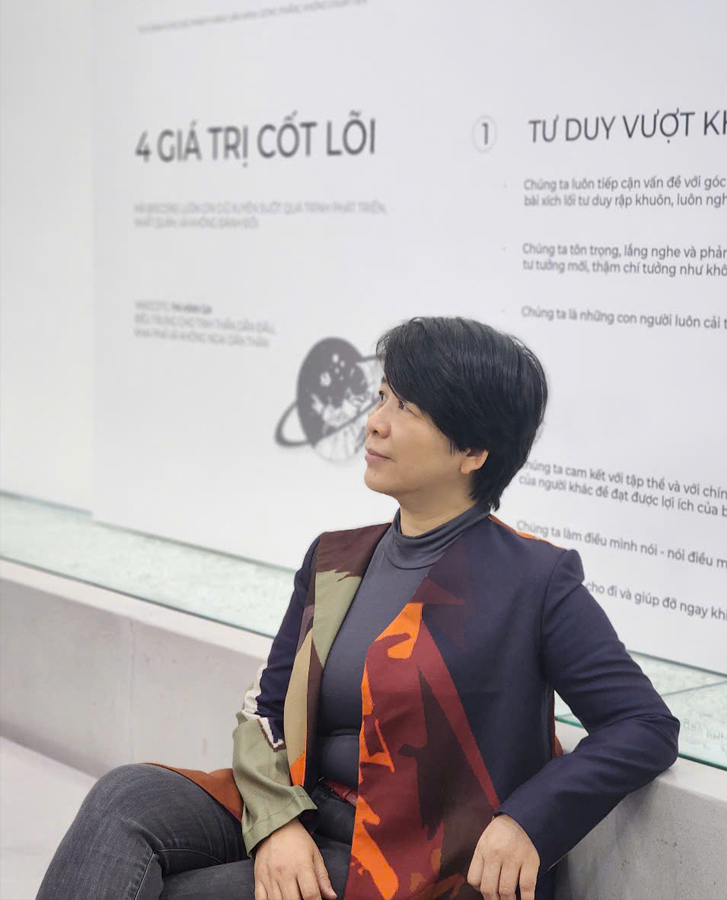The Journey to Discover the “Thuận Thiên” Philosophy: From Lý Dynasty Dragons to Metaphysics
Như Hồng’s philosophical journey began with a profound moment: when she copied the image of the dragon from the Lý dynasty—a cultural symbol of Vietnam from the 10th century. The Lý dragon, simple yet majestic, is not merely an artistic figure but a lifeline, a breath, a miniature cosmic order. Như Hồng realized that any deviation in the brushstroke would disrupt the “order, dignity, and unique language” of this form. The question “Why?” led her deeper into the realms of philosophy and culture.

DRAGON – WHY – JOURNEY BEGINS
The Lý dynasty was a golden age for Buddhism in Đại Việt, especially with the flourishing of the Tì Ni Đa Lưu Chi Zen school—a lineage emphasizing intuitive enlightenment, simplicity, and harmony with nature. The teachings of this Zen tradition, with its focus on the primal essence of the mind and unity with the universe, became a key for Như Hồng to grasp the deeper meaning behind the Lý dragon. This image, with its simplicity yet formidable power, is a true embodiment of Zen spirit: unpretentious, unembellished, yet containing a metaphysical order—a harmony between humanity, nature, and the cosmos.
From the philosophical foundation of the Tì Ni Đa Lưu Chi school, Như Hồng turned to Platonic philosophy and immediately recognized the resonance. Plato, in his theory of Forms, posits that the material world is merely a shadow of an ideal world, where perfect forms—such as beauty and goodness—exist. To Như Hồng, the Lý dragon is not merely an image but a reflection of one such ideal form: its simplicity is its perfection, a manifestation of the cosmic order Plato called the world of Forms. The philosophical “language” of Zen became the decoder for Như Hồng to understand and connect with other schools of thought.
The “Thuận Thiên” Philosophy: Connecting the Metaphysical and the Invisible
Như Hồng’s “Thuận Thiên” philosophy, through this journey of discovery, is not merely about aligning with nature in the conventional sense (like respecting the environment), but about harmonizing with the invisible vibrations of the universe—a profound metaphysical concept. She believes that every action, every existence in the material world, creates invisible movements that open into abstract, parallel worlds in constant motion. For instance, when a woman walks in an “áo tứ thân,” the space behind her step is not merely physical—it is a doorway into metaphysical realities, where countless other worlds intersect and are affected by that very movement.
This perspective aligns with the metaphysics of Henri Bergson, who emphasized that reality is a continuous flow of time and movement (duration). Bergson argued that we often perceive reality through static concepts, but life’s essence is ceaseless motion, accessible only through intuition. In Như Hồng’s art, this invisible movement is expressed through shapes and colors that seem to flow—like a cosmic river—reflecting the heartbeat of reality in the spirit of Bergson.
The spirit of Japanese sumi-e painting also echoes in Như Hồng’s “Thuận Thiên” philosophy. In sumi-e, the void contains infinite creative potential—a space for the viewer to sense the invisible. Như Hồng adopts this notion when perceiving empty space in art and life: it is not absence, but the realm where metaphysical worlds move and multiply. Finally, Masaru Emoto’s discoveries on “water crystals”—where water responds to the vibrations of thoughts and emotions—affirm Như Hồng’s belief that invisible vibrations have the power to shape new realities. Each of her works, from paintings to design, is a “crystal of art,” where Vietnamese cultural resonance and the “Thuận Thiên” philosophy are crystallized.
Thuận Thiên and Vietnamese Culture: A Connection to Past and Future
Như Hồng’s “Thuận Thiên” philosophy is not just a metaphysical concept but a deep-rooted connection to Vietnamese culture. From the Lý dynasty dragon, she saw that Vietnamese culture, though simple, always contains a metaphysical order—a harmony between humanity, nature, and the universe, just as the Tì Ni Đa Lưu Chi Zen teaches. In her art, Như Hồng reinterprets Vietnamese culture through abstract forms and color fields that evoke memories of mountains, rivers, and fields—seen through a contemporary lens. This is her way of honoring the past without letting it fade, bringing it vibrantly into modern life.
Step into a world where art becomes a vessel for invisible vibrations, and every design reflects the harmony between humanity, nature, and the cosmos.
Through Như Hồng’s “Thuận Thiên” philosophy, your space is no longer just a place — it transforms into a living story of cultural memory and metaphysical beauty.
Visit nhuhongart.com to explore the collections.
Are you ready to awaken your space with timeless resonance and art?




